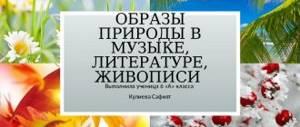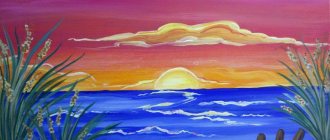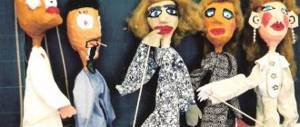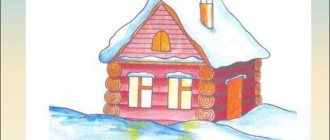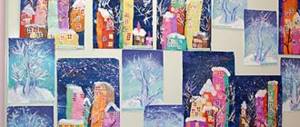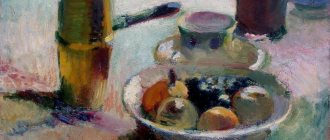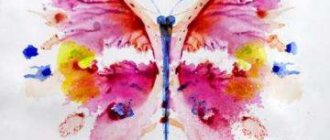Landscape in Russian painting. Fine Arts 6th grade.
Fine Arts 6th grade
Landscape in Russian painting
I.I. Levitan. June day.
- Landscape in Russian art began to emerge from the beginning of the 19th century, then ideas about the beauty of nature were romantic; only distant, warm countries seemed beautiful.
- For the first time, the image of Russian nature appeared in the works of A. G. Venetsianov. He created on his canvases a poetic, ideal, peace-breathing world of rural life, where there is no suffering or hard work.
A.G. Venetsianov. Sleeping shepherdess. Russia 19th century
- Aleksey Savrasov's painting “The Rooks Have Arrived” was called “the spring of the Russian landscape.” Savrasov was the first to see the world around him with the sincere gaze of a simple person; he opened people’s eyes to the amazing beauty and poetry of what was considered ugly.
A.K.Savrasov. The Rooks Have Arrived. Oil. Russia. XIX century
- Fyodor Vasiliev's landscapes embody subtle observations of the variability of nature, conveying its breath, subtle changes in the weather.
F.A. Vasiliev. Wet meadow. Russia 19th century
The middle of the 19th century was the heyday of Russian landscape painting.
- In the artistic discovery of the Russian landscape, a special role belongs to Ivan Ivanovich Shishkin. He sang our nature as an epically powerful, heroic land with the free sweep of plains and the grandeur of forests.
I.I. Shishkin. Oak Grove. Russia 19th century
I.I. Shishkin. Rye.
The most soulful Russian artist is the landscape painter Isaac Ilyich Levitan. And the most significant.
- Levitan is a great lyricist. He liked the words of M.Yu. Lermontov: “He breathed the same life with nature...”. Levitan had a special sensitivity in understanding the states of nature; they resonated in his soul. For Levitan, nature is the second “I”.
I.I. Levitan. XIX century Stormy day.
- Levitan's favorite place, where he worked best, was the picturesque town of Plyos. One of his most remarkable paintings is “Evening Bells”. It conveys the feeling of nature, when the pre-sunset calm gives a feeling of quiet joy and the evening ringing of bells floats above the earth, as if repeating itself in the movement of clouds and reflections of the river. This landscape evokes a quiet, almost prayerful state...
I.I. Levitan. Evening call, evening Bell.
- Levitan's painting “Spring. Big Water" carries within itself the emotion of a poetic image; it is consonant with the musical images of P.I. Tchaikovsky, the great composer and contemporary of Levitan.
I.I. Levitan.
Spring. Big water.
- Levitan's most ambitious work is “Above Eternal Peace.” The painting embodies the artist’s thoughts about the eternity of the world and the frailty of human life and at the same time about the power of inspiration.
- Levitan's work had a huge influence on the future fate of Russian landscape painting and the painting of other countries and peoples.
I.I. Levitan. Over eternal peace.
Assignment: Paint the landscape “My Country” or “The Distances of My Motherland” with paints. Choose the mood, the state in nature that you want to convey.
Decide what time of year you want to depict. Start your work with an image of the earth and sky, creating a general coloristic (color) mood of the landscape, and only then add trees and a river into it. A road stretching into the distance, etc.
Project work on the theme “Landscape”
Slide 1
Project work on the theme “Landscape” Completed by a 6th grade student Anastasia Fedorova Project leader: Svetlana Kuangalievna Maskarbaeva
Slide 2
Landscape Landscape (French Paysage, from pays - country, area) is a genre of fine art (as well as individual works of this genre), in which the main subject of the image is pristine nature, or nature transformed to one degree or another by man. Modern ideas about landscape have been formed over the centuries with the development of artistic techniques for its depiction. In a landscape work, special importance is attached to the construction of perspective and composition of the view, conveying the state of the atmosphere, air and light environment, and their variability.
Slide 3
Elements, Views and Character of a Landscape Landscape usually depicts open space. It usually presents an image of the water and/or earth surface. Depending on the direction - vegetation, buildings, technology, meteorological (clouds, rain) and astronomical (stars, sun, moon) formations. Sometimes the artist also uses figurative inclusions (people, animals), mainly in the form of relatively fleeting plot situations. In a landscape composition, however, they are given a clearly secondary importance, often the role of staffage. Depending on the type of motif depicted, one can distinguish rural, urban (including architectural - veduta and industrial) landscape. A special area is the image of the sea element - seascape or marina. At the same time, landscapes can be either intimate or panoramic. In addition, the landscape can be epic, historical, heroic, lyrical, romantic, fantastic and even abstract.
Slide 4
Isaac Levitan was born on August 18 (30), 1860 in the town of Kibartai, Suwalki province in Lithuania, into an educated, impoverished Jewish family. Father Ilya (Elyashiv Leib) Levitan (1827-1877) - from a rabbinical family from Kėdainiai, a place notable for the coexistence of Jewish and Scottish communities in Lithuania. Elyashiv studied at the yeshiva in Vilna. While self-educating, he independently mastered the French and German languages. In Kovno, he taught these languages, and then worked as a translator during the construction of a railway bridge, which was carried out by a French company. In November 2010, interesting archival records about the family of Isaac Levitan were discovered. In addition to Isaac, three more children grew up in the family: brother Abel-Leib (Adolf) and sisters Teresa (married Teresa Ilinichna Berchanskaya, b. 1856) and Michle (Emma Ilinichna, b. 07/18/1859 according to the old style). The nephews of Isaac Levitan, the sons of his sister Teresa Bertchansky, are the artists Leo (English Leo Birchansky, 1887-1949) and Raphael (French Raphaël Birtchansky, 1883-1953) Bertchansky.
Slide 5
Jules Dupre J. Dupre was born into the family of a manufacturer of porcelain products. As a landscape artist, he made his debut in 1831 at the Paris Salon with five of his works. He painted almost exclusively French landscapes (except for some works of 1835-1839 created in England). In 1867, 12 paintings by J. Dupre were shown at the World Exhibition. After this, the artist did not exhibit his works for a long time - until the National Exhibition of 1883, where eight new works of his could be seen. J. Dupre was awarded the rank of officer of the Legion of Honor. J. Dupre is a representative of the so-called “intimate landscape”, which reflected not so much the beauty of the depicted nature, but rather its correspondence to the artist’s mood and experiences, presented through paint, line and light.
Slide 6
Camille Pissarro Camille Pissarro was born on July 10, 1830 on the island of St. Thomas (West Indies), into a bourgeois family of Sephardic Jew Abram Pissarro and Rachelle Manzano-Pomier, a native of the Dominican Republic. Until the age of 12, Camille lived in the West Indies, then, at the age of 25, he and his entire family moved to Paris. After graduating from school, he again traveled to Saint-Thomas, as well as to Venezuela, where, together with his friend, the Danish artist Melbu, he mastered the art of painting in Caracas. In 1855 he finally returned to France. From 1855 to 1861 he studied at the Ecole des Beaux-Arts and the Académie Suisse in Paris. His teachers included Camille Corot, Gustave Courbet and Charles-François Daubigny. Took private lessons from I. Danyan. The main subjects of his works during this period are rural landscapes, as well as views of Paris. During the Franco-Prussian War of 1870–1871, Pissarro moved to London. During this time, many of his works, left in Paris, were destroyed by German soldiers living in his house. Only forty paintings have survived.
Slide 7
Sicel Alfren Sisley was born on October 30, 1839 in Paris, his father was the British merchant William Sisley (Sisley). In 1857 Alfred's parents sent him to London to study commerce, but the young man preferred to paint and returned to Paris in 1862. Upon his return, he entered the studio of Charles Gleyre, where he became close to Claude Monet, Camille Pissarro, Auguste Renoir and Frédéric Bazille, with whom he soon formed an Impressionist partnership. The greatest influence on Sisley as an artist were the British masters William Turner, John Constable and Richard Parkes Bonington, as well as the French Camille Corot, Gustave Courbet and Eugene Boudin. In 1866, Sisley married Marie Eugenie Lecuezec - from this marriage two children were born. A family portrait of the Sisleys was painted in 1868 by a family friend, Auguste Renoir.
Slide 8
Vancent Van Gogh Vincent Van Gogh was born on March 30, 1853 in the village of Groot Zundert in the province of North Brabant in the south of the Netherlands, near the Belgian border. Vincent's father was Theodore Van Gogh, a Protestant pastor, and his mother was Anna Cornelia Carbenthus, the daughter of a venerable bookbinder and bookseller from The Hague. Vincent was the second of seven children of Theodore and Anna Cornelia. He received his name in honor of his paternal grandfather, who also devoted his entire life to the Protestant church. This name was intended for Theodore and Anna's first child, who was born a year earlier than Vincent and died on the first day. So Vincent, although born second, became the eldest of the children.
Slide 9
Pierre Auguste Renoir Pierre Auguste Renoir (French Pierre-Auguste Renoir; February 25, 1841, Limoges - December 2, 1919, Cagnes-sur-Mer) - French painter, graphic artist and sculptor, one of the main representatives of impressionism. Renoir is known primarily as a master of secular portraiture, not devoid of sentimentality; he was the first of the impressionists to gain success among wealthy Parisians. In the mid-1880s. actually broke with impressionism, returning to the linearity of classicism, to Engrism. Father of the famous director
